Using climate and environmental challenges to build trust in conflict-affected areas: Q&A with the Weathering Risk Peace Pillar
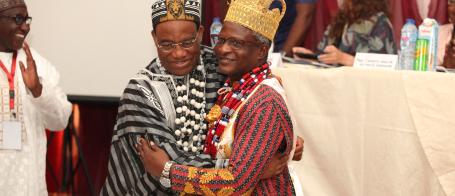
Peace Process in Nigeria
Climate change and environmental degradation are drastically reducing the availability of natural resources that millions around the world rely on, undermining livelihoods, economies and driving displacement. These environmental impacts are intensifying the risk of conflict, especially in areas struggling with ongoing violence or in the aftermath of conflicts. Climate change and environmental challenges have also, however, been found to provide a common ground around which people can unite, enabling groups at risk of conflict to jointly tackle shared issues, helping to build trust between them.
The Weathering Risk Peace Pillar is harnessing the integration of climate and environmental challenges into peace programming for improved outcomes in regions severely affected by both violent conflict and climate change. Across Nigeria, Iraq, Somalia, the Bay of Bengal and Yemen, the Peace Pillar is already improving trust-building, a key step to peace.
But what does this look like in practice? Partners from all five of the Peace Pillar’s projects shared how climate and environmental considerations are being harnessed in their projects. Check out more from the conversation below.
Nigeria
HD’s experience in Nigeria has shown that for peace agreements on natural resources to be sustainable, their implementation needs to be supported by development, climate and environmental actors.
Caroline Nyaga, Centre for Humanitarian Dialogue (HD)
More about the project: Multi-level approaches for peace in Nigeria’s Middle Belt
- Q: Why prioritise resource sharing over ownership?
Climate Diplomacy: The natural resource sharing peace agreements that HD has supported so far prioritise shared access and joint management of resources, over ownership of them. Can you tell us why this is the priority, and what impact it has had on trust and peacebuilding work so far?
Caroline Nyaga (HD): Natural resource ownership is an emotive and culturally linked subject. De-emphasising these aspects during a dialogue process allows space for trust and confidence building between groups in conflict, critical for resolution. Further, ownership issues often have litigation tied to them, which is also a likely barrier to consensus building. Underscoring shared access and joint management of natural resources with the parties in conflict is therefore key. This not only acts as a precursor for coexistence, cohesion and sustainable peace, but also provides impetus for socio-economic development. Furthermore, focusing on resource sharing has proven to be a practical avenue for creating an enabling environment for women and youth to contribute meaningfully to negotiations, for example the determination of markets, as they are the main producers and procurers of food.
As part of the Peace Pillar, HD has successfully facilitated the resolution of conflict between the Tiv and Igede communities that persisted for decades. This peace agreement demonstrates the capacity of those in conflict to come together and move past issue of ownership, and agree to the joint management of contested natural resources, benefiting entire communities.
- Q: What cooperation is needed to achieve the types of cross-sectoral positive outcomes?
Climate Diplomacy: Too often, peace, humanitarian, development and climate actors work in silo. Looking at the peace agreements, dialogues, and resource sharing initiatives that HD has been involved in Nigeria, what cooperation is needed between sectors to reach these sorts of outcomes?
Caroline Nyaga (HD): There needs to be a deliberate effort to build synergies between peace, humanitarian and development actors, and now climate actors as well. This is critical to ensure the sustainability of efforts and ensure the most efficient use of resources. HD’s experience in Nigeria has shown that for peace agreements to be sustainable, they need to consider development, climate and environmental dimensions. The inclusion of climate and environmental considerations in resource sharing agreements provides an enabling environment for interventions that are sustainable and scalable. HD’s natural resource peace processes have also highlighted the need for cross-sectoral cooperation at an early stage. Ideally, engagement with different sectors should start early – and not after an agreement has been signed.
Caroline Nyaga (HD): There needs to be a deliberate effort to build synergies between peace, humanitarian and development actors, and now climate actors as well. This is critical to ensure the sustainability of efforts and ensure the most efficient use of resources. HD’s experience in Nigeria has shown that for peace agreements to be sustainable, they need to consider development, climate and environmental dimensions. The inclusion of climate and environmental considerations in resource sharing agreements provides an enabling environment for interventions that are sustainable and scalable. HD’s natural resource peace processes have also highlighted the need for cross-sectoral cooperation at an early stage. Ideally, engagement with different sectors should start early – and not after an agreement has been signed.
Iraq
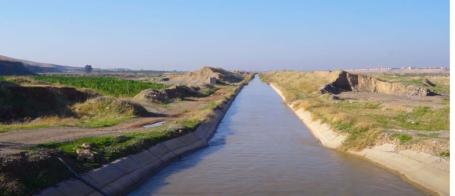
Iraq
By focusing on nationally relevant issues like climate, peace and security, we can bridge political and social divides, and foster cooperation and trust between all stakeholders involved.
Peshtiwan AlDawoudi, Berghof Foundation
More about the project: Strengthening Iraqi capacities to respond to climate risks and their impact on existing conflict dynamics
- Q: How can climate considerations be used to rebuild trust in Iraq?
Climate Diplomacy: Building trust in government isn’t an easy task, especially so in places fractured by decades of conflict such as Iraq. How exactly can climate considerations be used to rebuild trust in conflict and post-conflict settings?
Peshtiwan AlDawoudi (Berghof Foundation): In our programming in Iraq, we recognise that everyone, regardless of political background or affiliation, is affected by climate change, albeit in different ways. This shared vulnerability provides a common ground for building trust.
To build trust effectively, we've embraced a context-sensitive approach to local dialogue. We’ve learned that a one-size-fits-all model can alienate communities, as each has unique experiences, conflict histories and climate change impacts. We therefore carry out in-depth assessments to understand the specific context of each community before engaging. For instance, in Basra, climate change impacts are primarily felt through migration from neighbouring governorates, while in the agricultural community of Kalar, competition for water resources is the main issue. This tailored and contextualised approach is important for us to build trust with communities.
Further, the involvement of local governments is crucial for sustainable solutions to climate-related conflicts. Our programming ensures a collaborative process involving local authorities and community representatives, fostering a sense of ownership that promotes communities as co-implementers, thereby increasing trust in the project and commitment to its outcomes.
In Hawija, for example, we rehabilitated the water station that feeds into the water canal, through collaboration with the water directorate, instead of using third party contractors. This approach helps to strengthen the relationship between authorities and communities.
- Q: How to bring diverse stakeholders together leveraging climate and environmental change?
Climate Diplomacy: Ensuring that peace programming supports and complements existing local and national mechanisms is crucial for effective and just interventions. How do you bring the various stakeholders at different levels involved in your work together, and how is climate and environmental change considered?
Peshtiwan AlDawoudi (Berghof Foundation): In Iraq, we emphasise multi-level implementation to effectively connect stakeholders addressing climate and environmental challenges. Our approach creates an inclusive top-down and bottom-up platform that brings together diverse stakeholders for a unified effort.
At the local level, we engage in dialogues and gather feedback from local authorities to identify gaps that can be addressed at the national level. At the national level, we host roundtables to discuss gaps identified through community research. For example, in Baghdad, representatives from the Kurdistan Regional Government and the Federal Government of Iraq discussed priorities such as coordination between institutions and data-sharing related to climate-conflict.
Our national dialogues also involve international stakeholders. For instance, a roundtable in Erbil on climate security and conflict included international climate actors. This promotes a complementary approach, reduces the risk of duplication and builds synergies among organizations to ensure our work is impactful. The climate, peace and security nexus serves as a common denominator in this multi-level engagement. By focusing on nationally relevant issues like climate, peace and security, we can bridge political and social divides, and foster cooperation and trust between all stakeholders involved.
Somalia
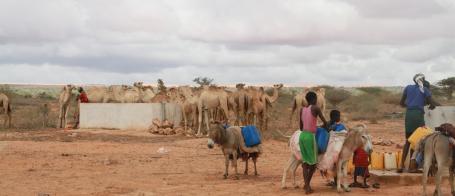
Somalia
We need to understand the environment as an actor at the negotiation table. If that’s not the case, no peace agreement can be sustainable.
Pascal Grimm, Berghof Foundation
More about the project: Infrastructures for Peace and Environmental Peacebuilding in Hirshabelle and Galmudug States, Somalia
- Q: How can Climate Security Action Plans to promote dialogue between conflicting parties in Somalia?
Climate Diplomacy: In close consultation with state authorities and your Insider Peacebuilders Network, you developed Climate Security Action Plans for conflict hotspots in Somalia. Can you provide a brief explanation of these action plans and how you will use them in your peacebuilding work moving forward?
Pascal Grimm (Berghof Foundation): The project has developed two Climate Security Action Plans (CSAPs) for conflict-affected districts: One in Adale, Hirshabelle State, and the other one in Guriel and Balanbale, Galmudug State. Both regions face violent conflict and severe climate change impacts. Our aim was to understand how these affect local livelihoods and conflicts, what challenges communities face, how they are adapting, and what needs remain. Based on focus group discussions, the status quo is analysed and recommendations for short- and long-term action are formulated. These tools serve as conversation starters for the inclusive dialogues that we are currently conducting in Adale and Guriel. Here, groups have been fighting over natural resources, grazing land and water rights for many years and there is a strong sense of distrust and resentment between them. We are trying to restart the dialogue by discussing the potential for collaboration between groups in conflict around environmental restoration and climate resilience. There have been local mediation efforts in the past, but none with an environmental lens. However, we need to recognize the environment as an actor at the negotiation table. If that’s not the case, no peace agreement can be sustainable.
- Q: How has radio featured in efforts to build trust, peace and climate resilience?
Climate Diplomacy: Berghof has been airing radio shows in Galmudug state in Somalia that promote awareness of the nexus of environment degradation, climate change and conflict. Listeners from Galmudug state and beyond have expressed how much the shows have resonated with them. Could you explain the impact these shows have had on listeners so far?
Pascal Grimm (Berghof Foundation): Our radio programme in Galmudug, Garasho-wadaag (Somali for “sharing knowledge”), has aired on several radio stations across the state for a few years. The idea was to reach an entirely different – and larger – audience with it. Radio is still a very popular medium, especially in rural areas, amongst pastoralists and farmers. These are often the people who feel the impact of climate change the most and those whose livelihoods are severely threatened by it. It’s also where most violent conflicts break out. The topics discussed in the show revolve around questions of peace, conflict, environment and climate change. Each episode provides a platform for local peacebuilders, experts and also government representatives to discuss and share their insights and positions. And we also give listeners the opportunity to call in and join the conversation. The overwhelmingly positive feedback from guests, callers, and social media has prompted the programme to switch from a monthly to a bi-weekly schedule in 2024, with plans to further expand in the future. Listeners appreciate the calls for their reconciliatory tone and environmental action and find the constructive nature of the discussions exemplary.
Bay of Bengal
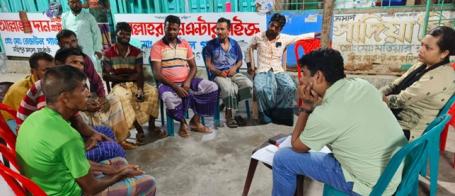
Bay of Bengal
The Bay of Bengal Maritime Dialogue provides a platform for vulnerable community members to share their vision for the region as key stakeholders, making policy and political processes more inclusive.
Sreejith Sugunan, Centre for Humanitarian Dialogue (HD)
More about the project: Bay of Bengal Maritime Dialogue
- Q: How can research promote trust-building and inter-state cooperation?
Climate Diplomacy: As part of project, the Centre for Humanitarian Dialogue works to strengthen joint marine scientific research with the littoral states of the Bay (India, Sri Lanka, Myanmar, Bangladesh, Thailand, Malaysia and Indonesia). How does this kind of science diplomacy promote inter-state cooperation?
Sreejith Sugunan (HD): Today, we are witnessing two major challenges in the Bay of Bengal, one of the world’s largest marine ecosystems, and home to more than 1-billion people. The first is increasing inter-state competition over marine resources. The second interconnected issue is increasing marine environmental degradation and its negative impact on ecosystems and communities. For example, irregular rainfall patterns and rising sea levels have led to an uptick in flooding in the coastal areas of the Bay. Rising temperatures have also contributed to drought and soil deterioration in the wider region, leading to food insecurity, displacement and cross-border migration. As these challenges are likely to be further exacerbated by climate change, it is important to facilitate diplomatic efforts to address them.
HD’s Bay of Bengal Maritime Dialogue program uses preventive diplomacy to tackle these challenges by enhancing interstate cooperation between the littoral states through the promotion of regional scientific collaboration. HD supported the formation of a Bay of Bengal Marine Research Network in 2023, under the aegis of a regional fisheries advisory body. This network of experts from different states is helping address these regional challenges, including fish-stock management and marine environmental degradation. Recently, the network evolved into BIMREN, an official research platform funded by the Indian government. The platform will empower regional scholars to conduct vital research on pressing issues in the Bay and provide sound recommendations for sustainable, collaborative solutions.
- Q: How is HD using environmental and climatic topics to build more inclusive political processes?
Climate Diplomacy: The brunt of climate and environmental impacts are felt by communities, but addressing these challenges is often confined to the work of state actors. In the Bay of Bengal, HD aims to bridge this gap by using environmental and climatic topics to bring in local voices in high level political discussions. How exactly are you using these issues to build more inclusive political processes? ´
Sreejith Sugunan (HD): One way that HD adds value to the existing policy landscape is by promoting and supporting bottom-up policymaking in the region. Our dialogue platform provides an avenue for highlighting perspectives and concerns of those most affected by climate change in the Bay of Bengal. In addition, we work with local experts to conduct research and generate evidence on the effectiveness of existing policies.
In Bangladesh, for example, we worked with partners to conduct a study on the effectiveness of a fishing ban as a policy instrument to mitigate further marine environmental degradation. A key part of this study was to gather perspectives of local fishers directly impacted by the ban. These insights not only inform our dialogue process, but we also seek to communicate findings with relevant decision-making institutions in the littoral states. The Bay of Bengal Maritime Dialogue provides a platform for vulnerable community members to share their vision for the region as key stakeholders, making policy and political processes more inclusive.
Yemen
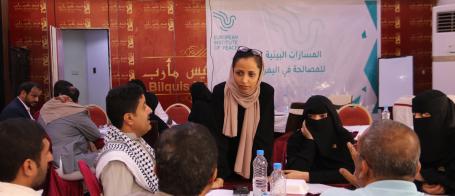
Community dialogue in Yemen
We have found that the environment and climate change, perceived as less contentious than power sharing or other issues, can help bring different parties together. People who wouldn't normally talk to each other were now sitting around the same table.
Hisham Al-Omeisy, European Institute of Peace
More about the project: Environmental Pathways for Reconciliation in Yemen
- Q: How does a focus on climate and environmental security impact marginalised groups?
Climate Diplomacy: Groups that tend to be marginalised in political decision-making play a key role in your work. Why does EIP focus on marginalized groups and on considerations of environment and climate change?
Hisham Al-Omeisy (EIP): Yemen has a long history of struggles over power and resources, which have resulted in recurring conflicts and remain a crucial dimension of the current civil war, which escalated 10 years ago. In a consultation with nearly 16,000 Yemenis in 2020-2021, 78% of respondents considered themselves unrepresented by existing political avenues. For any peace efforts to be meaningful and receive the required support from the broader population, they must be rooted in an inclusive engagement process.
This is particularly important in environmental peacemaking, as it deals with intersecting vulnerabilities and risk factors. Climate change is known to exacerbate existing inequalities across the globe. In Yemen, those who are most affected and vulnerable to the risks emerging from environmental degradation and climate change – for instance, farmers, fishers, IDPs, and their families – rarely make it to the forefront of political decision-making.
By explicitly consulting these and other marginalised groups, such as women and youth, the project encourages the Yemeni population to share their perspectives on the environment in relation to conflict. By engaging with a range of stakeholders from community members to the international level, the project advocates for the integration of these views and experiences into conflict resolution and prevention to foster sustainable peace. It also creates spaces to jointly reflect on the extent of environmental degradation in Yemen and its impacts on livelihoods, peace and conflict, and to identify entry points to address environmental risks while contributing to peacemaking and reconciliation.
- Q: How can climate and environmental considerations serve as entry points in the “forgotten crisis?”
Climate Diplomacy: Escalations this year have drawn international attention back to Yemen’s war, often dubbed the “forgotten crisis.” How has this shaped your work and how, if at all, can the focus now on environmental and climate considerations be leveraged to support ongoing peacemaking efforts in Yemen?
Hisham Al-Omeisy (EIP): The recent escalations in Yemen and the broader region, with the situation in the Red Sea at the forefront of international attention, is a two-sided coin. First and foremost, it raises serious concerns about the country's humanitarian situation, which is set to worsen – already, two-thirds of Yemenis depend on humanitarian assistance. The escalation also poses additional obstacles to identifying and prioritising entry points for peace and reconciliation within a political discourse centred around maritime security.
On the other hand, the renewed attention to the conflict in Yemen and its environmental dimension – often figuring as oil vessel catastrophes in the Red Sea – may provide an opportunity to develop innovative approaches that could help break the political deadlock. Environmental and climate change issues appear to be one such entry point that we seek to leverage in the current escalation of conflict. In a consultation with 2,400 Yemenis in 2023, which was conducted as part of this project, 85% considered it essential to address climate change in the short term. This demonstrates the value placed on the environment as an essential element underpinning local livelihoods and peaceful coexistence.
To explore and realise this potential, EIP facilitates discussions and community dialogues on the state of the environment and its links to conflict and peace. We realised that environment and climate change, perceived as less contentious than power sharing or other issues, can help bring different parties together. People who normally wouldn't talk to each other were now sitting at the same table. This had a significant impact – there were now exchanges about shared resources, soil degradation, fishing ponds, clean water, and how solving these issues should be part of the peace process.
What can the Weathering Risk Peace Pillar teach us about the role of climate and the environment in building trust amidst conflict?
Across these highly diverse regions, communities and authorities from the local to regional levels are beginning to come together to build resilience against climate and environmental threats which undermine stability. By approaching these challenges together, groups at risk of conflict are beginning to trust one another, reducing the potential for violence, and increasing opportunities for collaboration. From across these projects, evidence from the Peace Pillar is beginning to show how approaching climate and environmental issues can build trust and lay the foundations for more sustainable peace. To support future efforts, the initiative has been systemically monitoring its work and developing lessons learned on the value of integrating climate and environmental security into peace programming. Further evidence is forthcoming.
This article was authored by Alina Viehoff, Laís Clemente, Sinéad Barry and Alexandra Steinkraus (adelphi). It was reviewed by Emma Whitaker (adelphi). It is based on a roundtable discussion hosted by the Weathering Risk Peace Pillar at the Third International Conference on Environmental Peacebuilding in The Hague, 19 June 2024. It has been edited for clarity.
The event featured the following speakers: Sreejith Sugunan (Centre for Humanitarian Dialogue), Caroline Nyaga (Centre for Humanitarian Dialogue), Hisham Al-Omeisy (European Institute of Peace), Peshtiwan AlDawoudi (Berghof Foundation), Pascal Grimm (Berghof Foundation). It was moderated by Alina Viehoff (adelphi).
Share on

